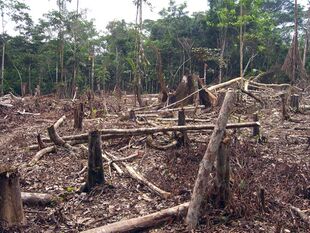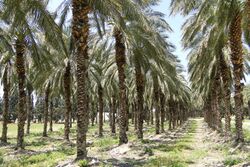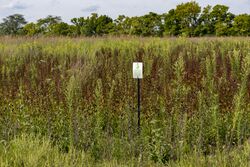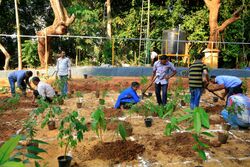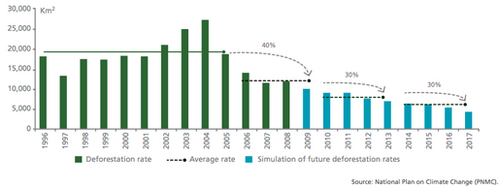Earth:Deforestation and climate change
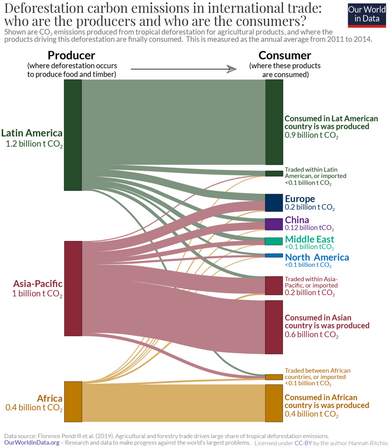
2 per year. That was 6.5% of global CO
2 emission. International trade was responsible for around one-third (29%) of the emissions. Most emissions – 71% – came from foods consumed in the country that they were produced (domestic demand).
Deforestation is a primary contributor to climate change,[1][2] and climate change affects forests.[3] Land use changes, especially in the form of deforestation,[4] are the second largest anthropogenic source of atmospheric carbon dioxide emissions, after fossil fuel combustion.[5] Greenhouse gases are emitted during combustion of forest biomass and decomposition of remaining plant material and soil carbon. Global models and national greenhouse gas inventories give similar results for deforestation emissions.[4] (As of 2019), deforestation is responsible for about 11% of global greenhouse gas emissions.[6] Carbon emissions from tropical deforestation are accelerating.[7][8] Growing forests are a carbon sink with additional potential to mitigate the effects of climate change. Some of the effects of climate change, such as more wildfires,[9] insect outbreaks, invasive species, and storms are factors that increase deforestation.[10][11]
Forests cover 31% of the land area on Earth and annually 75,700 square kilometers (18.7 million acres) of the forest is lost.[12] According to the World Resources Institute, there was a 12% increase in the loss of primary tropical forests from 2019 to 2020.[13]
Deforestation is often described as the changing of land from forested to non-forested by means both natural and unnatural. The relationship between deforestation and climate change is one of a positive feedback loop.[14] The more trees that are removed equals larger effects of climate change which, in turn, results in the loss of more trees.[15]
Deforestation comes in many forms: wildfire, agricultural clearcutting, livestock ranching, and logging for timber, among others.
Causes of deforestation
Causes not linked to climate change
Causes due to climate change
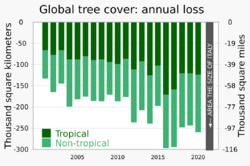
Effects of deforestation on climate change aspects
According to a review, north of 50°N, large scale deforestation leads to an overall net global cooling while tropical deforestation leads to substantial warming not just due to CO
2 impacts but also due to other biophysical mechanisms (making carbon-centric metrics inadequate). Irreversible deforestation would result in a permanent rise in the global surface temperature.[17] Moreover, it suggests that standing tropical forests help cool the average global temperature by more than 1 °C.[18][19]
Deforestation of tropical forests may risk triggering tipping points in the climate system and of forest ecosystem collapse which would also have effects on climate change.[20][21][22][23]
Deforestation, particularly in large swaths of the Amazon, where nearly 20% of the rainforest has been clear cut, has climactic effects and effects on water sources as well as on the soil.[24][25] Moreover, the type of land usage after deforestation also produces varied results. When deforested land is converted to pasture land for livestock grazing it has a greater effect on the ecosystem than forest to cropland conversions.[26] Other effect of deforestation in the Amazon rainforest is seen through the greater amount of carbon dioxide emission. The Amazon rainforest absorbs one-fourth of the carbon dioxide emissions on Earth, however, the amount of CO
2 absorbed today decreases by 30% than it was in the 1990s due to deforestation.[27]
Modeling studies have concluded that there are two crucial moments that can lead to devastating effects in the Amazon rainforest which are increase in temperature by 4 °C and deforestation reaching a level of 40%.[28]
Decrease in climate services
Human activity such as deforestation for livestock grazing and fuel wood has led to forest degradation and over extraction resulting in ecosystem biodiversity loss. Loss and degradation of forest has a direct impact on the Earth's diverse flora and fauna and, therefore, on climate change because they are the best defense against CO
2 buildup in the atmosphere.[29][30][31] If there is more foliage photosynthesizing more CO
2 will be absorbed, thereby balancing the potential temperature increases.[32]
Forests are nature's atmospheric carbon sink; plants take in atmospheric carbon dioxide (a greenhouse gas) and convert the carbon into sugars and plant materials through the process of photosynthesis.[33] The carbon is stored within the trees, vegetation, and soil of the forests. Studies show that "intact forests", in fact, do sequester carbon.[34] Examples of large forests that have a significant impact on the balance of carbon include the Amazonian and the Central African rainforests.[35] However, deforestation disrupts the processes of carbon sequestration and affects localized climates. Additionally, cutting down trees plays a role in a positive feedback loop centered around climate change on a much larger scale, as studies are finding.[34]
When a climate changes, this causes the shift in a species' geographic range in order to maintain the climatic conditions (temperature, humidity) it is accustomed to. Ecological zones will shift by approximately 160 km per 1 degree Celsius.[32] A reduction in the area of any habitat, but particularly in forest habitat along with climatic change, enables species invasion and the possibility of biotic homogenization as stronger invasive species can take over weaker species in a fragile ecosystem.[32] Humans will also be impacted by the loss of biodiversity as food, energy, and other 'ecosystem goods and services' patterns are disrupted.[36]
Burning or cutting down trees reverses the effects of carbon sequestration and releases greenhouse gases (including carbon dioxide) into the atmosphere.[35] Furthermore, deforestation changes the landscape and reflectivity of earth's surface, i.e. decreasing Albedo. This results in an increase in the absorption of light energy from the sun in the form of heat, enhancing global warming.[34]
Changes in rainfall
As a consequence of reduced evapotranspiration, precipitation is also reduced. This implies having a hotter and drier climate, and a longer dry season.[37][38] This change in climate has drastic ecological and global impacts including increases in severity and frequency of fires, and disruption in the pollination process that will likely spread beyond the area of deforestation.[38][37]
According to a study published in 2023, tropical deforestation has led to a significant decrease in the amount of observed precipitation.[39] By the year 2100, researchers anticipate that deforestation in the Congo will diminish regional precipitation levels by up to 8-10%.[39]
Forest fires
Statistics have shown that there is a direct correlation between forest fires and deforestation. Statistics regarding the Brazilian Amazon area during the early 2000s have shown that fires and the air pollution that accompanies these fires mirror the patterns of deforestation and "high deforestation rates led to frequent fires".[40]
The Amazon rainforest has recently experienced fires that occurred inside the forest when wildfires tend to occur on the outer edges of the forest.[13] Wetlands have faced an increase in forest fires as well.[13] Due to the change in temperature, the climate around forests have become warm and dry, conditions that allow forest fires to occur.[13]
Under unmitigated climate change, by the end of the century, 21% of the Amazon would be vulnerable to post‐fire grass invasion. In 3% of the Amazon, fire return intervals are already shorter than the time required for grass exclusion by canopy recovery, implying a high risk of irreversible shifts to a fire‐maintained degraded forest grassy state. The south‐eastern region of the Amazon is currently at highest risk of irreversible degradation.[41]
According to a study in tropical peatland forest of Borneo, deforestation also contributes to the increase in fire risk.[42]
Control measures and their effects on climate change
Reducing deforestation
Carbon sequestration through forestry
Reforestation, afforestation and agroforestry
Possible methods of reforestation include large-scale industrial plantations, the introduction of trees into existing agricultural systems, small-scale plantations by landowners, the establishment of woodlots on communal lands, and the rehabilitation of degraded areas through tree planting or assisted natural regeneration.[43]
Afforestation is the planting of trees where there was no previous tree coverage. There are three different types of afforestation that could have varying effects on the amount of carbon dioxide that is taken from the atmosphere. The three kinds of afforestation are natural regeneration, commercial plantations, and agroforestry.[44] Although afforestation can help reduce the carbon emissions given off as a result of climate change, natural regeneration tends to be the most effective out of the three.[44] Natural regeneration typically concerns a wide variety of vegetation, making natural forest levels so plants can receive sunlight to undergo photosynthesis. Commercial plantations typically result in mass amounts of lumber, which if used for fuel, will release the stored CO
2 back into the atmosphere. Agroforestry stores energy based on the size and type of plant, meaning that the effect will vary depending on what is planted.[44]
Wood harvesting and supply have reached around 550 million m3 per year, while the total increasing stock of European forests has more than quadrupled during the previous six decades. It now accounts for around 35 billion m3 of forest biomass.[45][46] Since the beginning of the 1990s, the amounts of wood and carbon stored in European forests have increased by 50% due to greater forest area and biomass stocks. Every year, European woods adsorb and store around 155 million tonnes CO
2 equivalent. This is comparable to 10% of all other sectors' emissions in Europe.[45][47][48]
The forestry industry tries to mitigate climate change by boosting carbon storage in growing trees and soils and improving the sustainable supply of renewable raw materials via sustainable forest management.[45][49]
Concerns with forestry projects
Policies and programs
Reducing emissions from deforestation and forest degradation in developing countries
The Bali Action Plan
The Bali Action Plan was developed in December 2007 in Bali, Indonesia.[50][51] It is a direct result of The Kyoto Protocol of December 1997.[52][31] One of the key elements of The Bali Action Plan involves a concerted effort by the member countries of The Kyoto Protocol to enact and create policy approaches that incentivize emissions reduction caused by deforestation and forest degradation in the developing world.[53] It emphasized the importance of sustainable forest management and conservation practices in mitigating climate change. This coupled with the increased attention to carbon emission stocks as a way to provide additional resource flows to the developing countries.[31]
Trillion Tree Campaign
The Billion Tree Campaign was launched in 2006 by the United Nations Environment Programme (UNEP) as a response to the challenges of global warming, as well as to a wider array of sustainability challenges, from water supply to biodiversity loss.[54] Its initial target was the planting of one billion trees in 2007. Only one year later in 2008, the campaign's objective was raised to 7 billion trees—a target to be met by the climate change conference that was held in Copenhagen, Denmark in December 2009. Three months before the conference, the 7 billion planted trees mark had been surpassed. In December 2011, after more than 12 billion trees had been planted, UNEP formally handed management of the program over to the not-for-profit Plant-for-the-Planet initiative, based in Munich, Germany.[55]
The Amazon Fund (Brazil)
Considered the largest reserve of biological diversity in the world, the Amazon Basin is also the largest Brazilian biome, taking up almost half the nation's territory. The Amazon Basin corresponds to two fifths of South America's territory. Its area of approximately seven million square kilometers covers the largest hydrographic network on the planet, through which runs about one fifth of the fresh water on the world's surface. Deforestation in the Amazon rainforest is a major cause to climate change due to the decreasing number of trees available to capture increasing carbon dioxide levels in the atmosphere.[56]
The Amazon Fund is aimed at raising donations for non-reimbursable investments in efforts to prevent, monitor and combat deforestation, as well as to promote the preservation and sustainable use of forests in the Amazon Biome, under the terms of Decree N.º 6,527, dated August 1, 2008.[57] The Norwegian Government, which is the largest donor to the fund, froze its funding in 2019 over deforestation concerns. Norway has tied the resumption of funding to proof of a reduction in deforestation.[58]
The Amazon Fund supports the following areas: management of public forests and protected areas, environmental control, monitoring and inspection, sustainable forest management, economic activities created with sustainable use of forests, ecological and economic zoning, territorial arrangement and agricultural regulation, preservation and sustainable use of biodiversity, and recovery of deforested areas. Besides those, the Amazon Fund may use up to 20% of its donations to support the development of systems to monitor and control deforestation in other Brazilian biomes and in biomes of other tropical countries.[57]
See also
- Biology:Land use, land-use change, and forestry – Greenhouse gas inventory sector
- Earth:Reducing emissions from deforestation and forest degradation – Climate change mitigation policy
- Earth:Natural Forest Standard – Voluntary carbon standard designed specifically for medium- to large-scale REDD+ projects.
References
- ↑ Sutter, John D. (13 August 2015). "10 climate change villains". https://www.cnn.com/2015/08/13/opinions/gallery/top-climate-change-contributors/index.html.
- ↑ Heidari, Hadi; Warziniack, Travis; Brown, Thomas C.; Arabi, Mazdak (February 2021). "Impacts of Climate Change on Hydroclimatic Conditions of U.S. National Forests and Grasslands" (in en). Forests 12 (2): 139. doi:10.3390/f12020139.
- ↑ US EPA, OAR (2022-10-19). "Climate Change Impacts on Forests" (in en). https://www.epa.gov/climateimpacts/climate-change-impacts-forests.
- ↑ 4.0 4.1 Climate Change and Land: Summary for Policymakers (Report). IPCC. August 2019. https://www.ipcc.ch/site/assets/uploads/2019/08/4.-SPM_Approved_Microsite_FINAL.pdf.
- ↑ "Main sources of carbon dioxide emissions | CO
2 Human Emissions". https://www.che-project.eu/news/main-sources-carbon-dioxide-emissions. - ↑ "How the UK contributes to global deforestation" (in en-GB). BBC News. 2020-08-26. https://www.bbc.com/news/newsbeat-53907739.
- ↑ Feng, Yu; Zeng, Zhenzhong; Searchinger, Timothy D.; Ziegler, Alan D.; Wu, Jie; Wang, Dashan; He, Xinyue; Elsen, Paul R. et al. (2022-02-28). "Doubling of annual forest carbon loss over the tropics during the early twenty-first century" (in en). Nature Sustainability 5 (5): 444–451. doi:10.1038/s41893-022-00854-3. ISSN 2398-9629. Bibcode: 2022NatSu...5..444F.
- ↑ Greenfield, Patrick (2022-02-28). "Deforestation emissions far higher than previously thought, study finds" (in en). https://www.theguardian.com/environment/2022/feb/28/deforestation-emissions-far-higher-than-previously-thought-study-finds-aoe.
- ↑ Heidari, Hadi; Arabi, Mazdak; Warziniack, Travis (August 2021). "Effects of Climate Change on Natural-Caused Fire Activity in Western U.S. National Forests" (in en). Atmosphere 12 (8): 981. doi:10.3390/atmos12080981. Bibcode: 2021Atmos..12..981H.
- ↑ Seymour, Frances; Gibbs, David (2019-08-08) (in en). Forests in the IPCC Special Report on Land Use: 7 Things to Know. https://www.wri.org/blog/2019/08/forests-ipcc-special-report-land-use-7-things-know. Retrieved 2020-03-20.
- ↑ "U.S. Environmental Protection Agency | US EPA" (in en). https://www.epa.gov/.
- ↑ "Deforestation and Forest Degradation". https://www.worldwildlife.org/threats/deforestation.
- ↑ 13.0 13.1 13.2 13.3 Seymour, Frances (2021-03-31) (in en). 2021 Must Be a Turning Point for Forests. 2020 Data Shows Us Why. https://www.wri.org/insights/2021-must-be-turning-point-forests-2020-data-shows-us-why.
- ↑ Bajželj, Bojana; Richards, Keith S. (2014). "The Positive Feedback Loop between the Impacts of Climate Change and Agricultural Expansion and Relocation" (in en). Land 3 (3): 898–916. doi:10.3390/land3030898. ISSN 2073-445X.
- ↑ Allen, Craig D.; Macalady, Alison K.; Chenchouni, Haroun; Bachelet, Dominique; McDowell, Nate; Vennetier, Michel; Kitzberger, Thomas; Rigling, Andreas et al. (February 2010). "A global overview of drought and heat-induced tree mortality reveals emerging climate change risks for forests" (in en). Forest Ecology and Management 259 (4): 660–684. doi:10.1016/j.foreco.2009.09.001. https://linkinghub.elsevier.com/retrieve/pii/S037811270900615X.
- ↑ Butler, Rhett A. (31 March 2021). "Global forest loss increases in 2020". Mongabay. https://news.mongabay.com/2021/03/global-forest-loss-increases-in-2020-but-pandemics-impact-unclear/. ● Mongabay graphing WRI data from "Forest Loss / How much tree cover is lost globally each year?". World Resources Institute — Global Forest Review. 2023. https://research.wri.org/gfr/forest-extent-indicators/forest-loss.
- ↑ Lewis, Trevor (1998-07-01). "The effect of deforestation on ground surface temperatures" (in en). Global and Planetary Change 18 (1): 1–13. doi:10.1016/S0921-8181(97)00011-8. ISSN 0921-8181. Bibcode: 1998GPC....18....1L. https://www.sciencedirect.com/science/article/pii/S0921818197000118.
- ↑ "Forests help reduce global warming in more ways than one". Science News. 24 March 2022. https://www.sciencenews.org/article/forest-trees-reduce-global-warming-climate-cooling-carbon.
- ↑ Lawrence, Deborah; Coe, Michael; Walker, Wayne; Verchot, Louis; Vandecar, Karen (2022). "The Unseen Effects of Deforestation: Biophysical Effects on Climate". Frontiers in Forests and Global Change 5. doi:10.3389/ffgc.2022.756115. ISSN 2624-893X. Bibcode: 2022FrFGC...5.6115L.
- ↑ Boulton, Chris A.; Lenton, Timothy M.; Boers, Niklas (March 2022). "Pronounced loss of Amazon rainforest resilience since the early 2000s" (in en). Nature Climate Change 12 (3): 271–278. doi:10.1038/s41558-022-01287-8. ISSN 1758-6798. Bibcode: 2022NatCC..12..271B.
- ↑ Walker, Robert Toovey (2 January 2021). "Collision Course: Development Pushes Amazonia Toward Its Tipping Point". Environment: Science and Policy for Sustainable Development 63 (1): 15–25. doi:10.1080/00139157.2021.1842711. ISSN 0013-9157. Bibcode: 2021ESPSD..63a..15W.
- ↑ Cooper, Gregory S.; Willcock, Simon; Dearing, John A. (10 March 2020). "Regime shifts occur disproportionately faster in larger ecosystems" (in en). Nature Communications 11 (1): 1175. doi:10.1038/s41467-020-15029-x. ISSN 2041-1723. PMID 32157098. Bibcode: 2020NatCo..11.1175C.
- ↑ Lovejoy, Thomas E.; Nobre, Carlos (20 December 2019). "Amazon tipping point: Last chance for action". Science Advances 5 (12): eaba2949. doi:10.1126/sciadv.aba2949. ISSN 2375-2548. PMID 32064324. Bibcode: 2019SciA....5A2949L.
- ↑ Morton, D. C.; DeFries, R. S.; Shimabukuro, Y. E.; Anderson, L. O.; Arai, E.; del Bon Espirito-Santo, F.; Freitas, R.; Morisette, J. (2006-09-14). "Cropland expansion changes deforestation dynamics in the southern Brazilian Amazon" (in en). Proceedings of the National Academy of Sciences 103 (39): 14637–14641. doi:10.1073/pnas.0606377103. ISSN 0027-8424. PMID 16973742. Bibcode: 2006PNAS..10314637M.
- ↑ Macedo, Marcia N.; DeFries, Ruth S.; Morton, Douglas C.; Stickler, Claudia M.; Galford, Gillian L.; Shimabukuro, Yosio E. (2012-01-24). "Decoupling of deforestation and soy production in the southern Amazon during the late 2000s" (in en). Proceedings of the National Academy of Sciences 109 (4): 1341–1346. doi:10.1073/pnas.1111374109. ISSN 0027-8424. PMID 22232692. Bibcode: 2012PNAS..109.1341M.
- ↑ Silvério, Divino V.; Brando, Paulo M.; Macedo, Marcia N.; Beck, Pieter S. A.; Bustamante, Mercedes; Coe, Michael T. (October 2015). "Agricultural expansion dominates climate changes in southeastern Amazonia: the overlooked non-GHG forcing" (in en). Environmental Research Letters 10 (10): 104015. doi:10.1088/1748-9326/10/10/104015. ISSN 1748-9326.
- ↑ "Amazon Deforestation and Climate Change" (in en). https://education.nationalgeographic.org/resource/amazon-deforestation-and-climate-change.
- ↑ Nobre, Carlos A.; Sampaio, Gilvan; Borma, Laura S.; Castilla-Rubio, Juan Carlos; Silva, José S.; Cardoso, Manoel (2016-09-27). "Land-use and climate change risks in the Amazon and the need of a novel sustainable development paradigm" (in en). Proceedings of the National Academy of Sciences 113 (39): 10759–10768. doi:10.1073/pnas.1605516113. ISSN 0027-8424. PMID 27638214. Bibcode: 2016PNAS..11310759N.
- ↑ Rosendal, G. Kristin (February 1995). "The forest issue in post-UNCED international negotiations: conflicting interests and fora for reconciliation". Biodiversity and Conservation 4 (1): 91–107. doi:10.1007/bf00115315. ISSN 0960-3115. Bibcode: 1995BiCon...4...91R.
- ↑ Rudel, Thomas K.; Meyfroidt, Patrick; Chazdon, Robin; Bongers, Frans; Sloan, Sean; Grau, H. Ricardo; Van Holt, Tracy; Schneider, Laura (January 2020). "Whither the forest transition? Climate change, policy responses, and redistributed forests in the twenty-first century" (in en). Ambio 49 (1): 74–84. doi:10.1007/s13280-018-01143-0. ISSN 0044-7447. PMID 30666613. Bibcode: 2020Ambio..49...74R.
- ↑ 31.0 31.1 31.2 Singh, P (August 2008). "Exploring biodiversity and climate change benefits of community-based forest management" (in en). Global Environmental Change 18 (3): 468–478. doi:10.1016/j.gloenvcha.2008.04.006.
- ↑ 32.0 32.1 32.2 Thuiller, Wilfried (August 2007). "Climate change and the ecologist". Nature 448 (7153): 550–552. doi:10.1038/448550a. ISSN 0028-0836. PMID 17671497.
- ↑ "Carbon Dioxide Fertilization Greening Earth, Study Finds." NASA, 26 April 2014, Accessed 8 February 2018.
- ↑ 34.0 34.1 34.2 Malhi, Y., et al. "Climate Change, Deforestation, and the Fate of the Amazon." Science, vol. 319, no. 5860, 11 January 2008, pp. 169–172., doi:10.1126/science.1146961.
- ↑ 35.0 35.1 "Deforestation and climate change." GREENPEACE, Accessed 8 February 2018.
- ↑ "Biodiversity and Health" (in en). https://www.who.int/news-room/fact-sheets/detail/biodiversity-and-health.
- ↑ 37.0 37.1 Rebecca, Lindsey (2007-03-30). "Tropical Deforestation: Feature Articles" (in en). https://earthobservatory.nasa.gov/Features/Deforestation/deforestation_update2.php.
- ↑ 38.0 38.1 Shukla, J.; Nobre, C.; Sellers, P. (1990-03-16). "Amazon Deforestation and Climate Change" (in en). Science 247 (4948): 1322–1325. doi:10.1126/science.247.4948.1322. ISSN 0036-8075. PMID 17843795. Bibcode: 1990Sci...247.1322S.
- ↑ 39.0 39.1 Smith, C.; Baker, J. C. A.; Spracklen, D. V. (March 2023). "Tropical deforestation causes large reductions in observed precipitation" (in en). Nature 615 (7951): 270–275. doi:10.1038/s41586-022-05690-1. ISSN 1476-4687. PMID 36859548. Bibcode: 2023Natur.615..270S.
- ↑ Thompson, Elizabeth (2021-08-27). "Amazon Deforestation and Fires are a Hazard to Public Health" (in en-US). http://eos.org/research-spotlights/amazon-deforestation-and-fires-are-a-hazard-to-public-health.
- ↑ Bruno, De Faria; Arie, Staal; Carlos, Silva; Philip, Martin; Prajjwal, Panday; Vinicius, Dantas; Thiago, Silva (December 2021). "Climate change and deforestation increase the vulnerability of Amazonian forests to post-fire grass invasion". Global Ecology & Biogeography 30 (12): 2368–2381. doi:10.1111/geb.13388. ISSN 1466-822X. Bibcode: 2021GloEB..30.2368D.
- ↑ Davies-Barnard, Taraka (Jan 24, 2023). "Future fire risk under climate change and deforestation scenarios in tropical Borneo". IOPscience 18 (2): 024015. doi:10.1088/1748-9326/acb225. Bibcode: 2023ERL....18b4015D.
- ↑ Zomer, Robert J.; Trabucco, Antonio; Bossio, Deborah A.; Verchot, Louis V. (2008-06-01). "Climate change mitigation: A spatial analysis of global land suitability for clean development mechanism afforestation and reforestation" (in en). Agriculture, Ecosystems & Environment. International Agricultural Research and Climate Change: A Focus on Tropical Systems 126 (1): 67–80. doi:10.1016/j.agee.2008.01.014. ISSN 0167-8809. Bibcode: 2008AgEE..126...67Z. http://www.sciencedirect.com/science/article/pii/S0167880908000169.
- ↑ 44.0 44.1 44.2 "Mapped: Where 'afforestation' is taking place around the world" (in en-US). 2021-08-31. https://www.resilience.org/stories/2021-08-31/mapped-where-afforestation-is-taking-place-around-the-world/.
- ↑ 45.0 45.1 45.2 Bank, European Investment (2022-12-08) (in EN). Forests at the heart of sustainable development: Investing in forests to meet biodiversity and climate goals. European Investment Bank. ISBN 978-92-861-5403-4. https://www.eib.org/en/publications/20220173-forests-at-the-heart-of-sustainable-development.
- ↑ Zhao, Jianheng; Wei, Xinyuan; Li, Ling (2022). "The potential for storing carbon by harvested wood products". Frontiers in Forests and Global Change 5. doi:10.3389/ffgc.2022.1055410. ISSN 2624-893X. Bibcode: 2022FrFGC...555410Z.
- ↑ "Forest-based bioeconomy and climate change mitigation: trade-offs and synergies" (in en). https://joint-research-centre.ec.europa.eu/jrc-news/forest-based-bioeconomy-and-climate-change-mitigation-trade-offs-and-synergies-2021-05-06_en.
- ↑ "Carbon footprint of tropical timber" (in en-US). https://www.idhsustainabletrade.com/publication/carbon-footprint-of-tropical-timber/.
- ↑ MÜLLER, Ulrike. "REPORT on a new EU Forest Strategy for 2030 – Sustainable Forest Management in Europe | A9-0225/2022 | European Parliament" (in en). https://www.europarl.europa.eu/doceo/document/A-9-2022-0225_EN.html.
- ↑ "Climate Change: The Kyoto Protocol, Bali "Action Plan," and International Actions" (in en). https://www.everycrsreport.com/reports/RL33826.html.
- ↑ "Bali Road Map Intro". https://unfccc.int/process/conferences/the-big-picture/milestones/bali-road-map.
- ↑ "United Nations Framework Convention on Climate Change". https://unfccc.int/.
- ↑ "International Deforestation and Climate Change". https://www.govinfo.gov/content/pkg/CHRG-110shrg45735/html/CHRG-110shrg45735.htm.
- ↑ "Commit to Action - Join the Billion Tree Campaign!". United Nations Environment Programme (UNEP). http://www.plant-for-the-planet-billiontreecampaign.org/About.aspx.
- ↑ "UNEP Billion Tree Campaign Hands Over to the Young People of the Plant-for-the-Planet Foundation" (Press release). UN Environment Programme. 7 December 2011. Archived from the original on 27 December 2011. Retrieved 20 October 2022.
- ↑ "Amazon Fund Activity Report 2013". Instituto Brasileiro de Geografia e Estatística (IBGE). http://www.amazonfund.gov.br/FundoAmazonia/export/sites/default/site_en/Galerias/Arquivos/Relatorio_Atividades/RAFA_Virtual_English_2013.pdf.
- ↑ 57.0 57.1 "Amazon Fund/Purposes and Management". Amazon Fund. http://www.amazonfund.gov.br/FundoAmazonia/fam/site_en/Esquerdo/Fundo/.
- ↑ Solsvik, Terje (2021-04-14). "Brazil must show Amazon protection is working, top donor Norway says". Reuters. https://www.reuters.com/business/environment/brazil-must-show-amazon-protection-is-working-top-donor-norway-says-2021-04-14/.
 |


